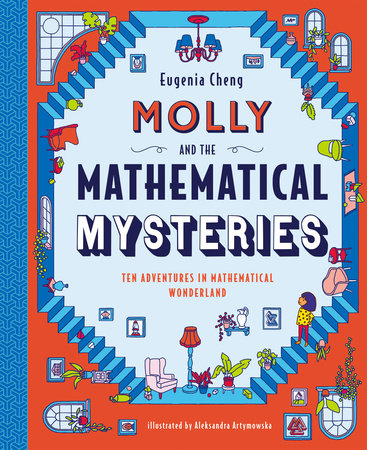
Molly and the Mathematical Mysteries: Ten Interactive Adventures in Mathematical Wonderland
Written by Eugenia Cheng
Illustrated by Aleksandra Artymowska
Candlewick, 2021, 30 pp
ISBN: 978-1536217100
This nonfiction global picturebook utilizes both a narrative story and excerpts on mathematical concepts to show that math is more than numbers and equations. Under the guidance of author Eugenia Cheng, herself a mathematician, and illustrator Aleksandra Artymowska, readers quickly learn that math is an adventure and can upend what is considered impossible.
This mathematical adventure begins with Molly, a young girl with a dark blue haircut, discovering a note in her bedroom, directing her to follow a rabbit through a rabbit hole. She is taken to many different rooms and places that are indicative of mathematical concepts like patterns, shapes, dimensions, number combinations, symmetry, and fractals. Each page represents a specific mathematical concept and along with the storyline following Molly there are multi-paragraph excepts explaining in very accessible terminology that specific concept. When Molly finds herself in The Garden of Hidden Shapes the illustrations and the excerpt on Tiling Shapes, help reinforce the concept of how certain shapes can fit together to make other shapes. Readers learn about equilateral triangles and tessellations by following Molly through a green hedge maze in an estate garden.
The true genius of the book lies in its format as it requires an active, not passive, reading audience to truly understand the math presented in it. It is an oversized picturebook, and the pages are thick cardstock. Each page spread is vivid, colorful, intricate, and interactive as readers are invited to open the multiple pop-ups and flaps, revealing the “secret” of mathematics as described on the page. The notes, which can be flipped up like real envelopes, end up being clues that point readers to what they should be searching for and manipulating within the pages. For example, in the spread about patterns and Latin Squares, the note instructs Molly and readers to open the long, rectangular pop-ups and connect and weave them as a way to help understand the concept of Latin Squares.
Some of the mathematical concepts may be too difficult for some readers to fully grasp; however, due to its interactive and playful nature, all readers are invited to play and engage, effectively sparking their curiosity around big ideas present in mathematical thinking. Some readers may not realize the concepts they are engrossed in, such is the nature of this exquisite text. Moreover, this book should be read and experienced front to back in order for readers to see how each topic feeds into the next. Multiple questions are posed on each spread as another way to spark questions, engagement, and exploration. At the end of the book there are two-page spreads dedicated to further explaining, with the aid of Artymowska’s detailed illustrations, the concepts readers investigated earlier.
To further explore the mathematical topics presented in Molly and the Mathematical Mysteries: Ten Interactive Adventures in Mathematical Wonderland, books on patterns, geometry, fractals, the Fibonacci Sequence, and the graphic artist whose mathematical works are present in this story, M. C. Escher, can be paired with it. This global STEM story can also be paired with Swirl by Swirl: Spirals in Nature by Joyce Sidman (2011), Zachary Zormer: Shape Transformer by Joanne Anderson Reisberg (2006), Mysterious Patterns: Finding Fractals in Nature by Sarah C. Campbell (2014), The Rabbit Problem by Emily Gravett (2010), and Make Believe: M.C. Escher for Kids by Kate Ryan (2018).
Eugenia Cheng is a British mathematician and pianist. While her previous books were geared towards adults, her mission is to bring advanced concepts in mathematics to a broader audience in a more accessible way. She is currently a Scientist in Residence at the School of the Art Institute of Chicago. More information about Eugenia can be found on her website.
Aleksandra Artymowska is an illustrator and graphic designer based in Poland and Israel. She graduated from the Academy of Fine Arts in Warsaw, Poland. Her love of mazes and puzzles has translated to her graphic design work along with her other picture books, including Alice in Wonderland: A Puzzle Adventure (2020) and 20,000 Leagues Under the Sea: A Puzzle Adventure (2019).
Sara Kersten-Parrish, John Carroll University
© 2021 by Sara Kersten-Parrish

WOW Review, Volume XIV, Issue 2 by Worlds of Words is licensed under a Creative Commons Attribution-NonCommercial-ShareAlike 4.0 International License. Based on work by Sara Kersten-Parrish at https://wowlit.org/on-line-publications/review/xiv-2/6/
